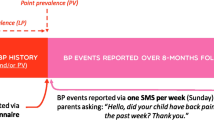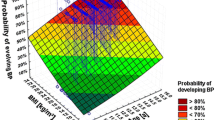Abstract
Purpose
To investigate the successive change of low back pain (LBP) prevalence in childhood and adolescence and to examine the associations between LBP and extracurricular sports activities (ECSA) or body mass index (BMI) using a 6-year birth cohort study.
Methods
LBP reports of a grade (4,597 pupils at the beginning) were tracked over 6 years (between the ages of 9 and 14 years old), and anonymous questionnaires were distributed to them yearly. After grading the severity of the LBP into three levels and noting the transitions of the point and the lifetime prevalence of LBP, associations between point prevalence of LBP and BMI or ECSA were evaluated.
Results
The point prevalence of LBP had a tendency to become significantly higher as the pupils got older until they became 13 years old. The lifetime prevalence of LBP significantly increased as they got older yearly. As for the severity of LBP among students with a lifetime prevalence, the rate of more severe LBP (levels 2 and 3) increased as they got older. Significant positive associations were recognized between BMI and point prevalence of LBP in every years old (p < 0.05) and between ECSA and point prevalence of LBP at 11 (p = 0.001) and 14 years old (p < 0.001).
Conclusions
The point and lifetime prevalence of LBP and the rate of more severe LBP increased as the pupils got older. BMI may be associated with LBP in childhood and adolescence.









Similar content being viewed by others
References
Balagué F, Dutoit G, Waldburger M (1988) Low back pain in schoolchildren. An epidemiological study. Scand J Rehabil Med 20:175–179
Balagué F, Nordin M, Skovron ML, Dutoit G, Yee A, Waldburger M (1994) Non-specific low-back pain among schoolchildren: a field survey with analysis of some associated factors. J Spinal Disord 7(5):374–379
Burton AK, Clarke RD, McClune TD, Tillotson KM (1996) The natural history of low back pain in adolescents. Spine 21:2323–2328
Cardon G, Balagué F (2004) Low back pain prevention’s effects in schoolchildren. What is the evidence? Eur Spine J 13:663–679 (Epub)
Grimmer K, Nyland L, Milanese S (2006) Longitudinal investigation of low back pain in Australian adolescents: a five-year study. Physiother Res Int 11:161–172
Harreby M, Neergaard K, Hesselsøe G, Kjer J (1995) Are radiologic changes in the thoracic and lumbar spine of adolescents risk factors for low back pain in adults? Spine 20:2298–2302
Hestbaek L, Leboeuf-Yde C, Kyvik KO, Manniche C (2006) The course of low back pain from adolescence to adulthood: eight-year follow-up of 9600 twins. Spine 31:468–472
Jones GT, Macfarlane GJ (2005) Epidemiology of low back pain in children and adolescents. Arch Dis Child 90:312–316
Kelsey JK, White AA (1985) Epidemiology and impact of low back pain. Spine 5:133–142
Kjaer P, Wedderkopp N, Korsholm L, Leboeuf-Yde C (2011) Prevalence and tracking of back pain from childhood to adolescence. BMC Musculoskelet Disord 12:98
Leboeuf-Yde C, Kyvik KO (1998) At what age does low back pain become a common problem? A study of 29,424 individuals aged 12–41 years. Spine 23:228–234
Mikkonen P, Leino-Arjas P, Remes J, Zitting P, Taimela S, Karppinen J (2008) Is smoking a risk factor for low back pain in adolescents? A prospective cohort study. Spine 33:527–532
Nacheson AL (1976) The lumbar spine: an orthopaedic challenge. Spine 1:59–71
Poussa MS, Heliövaara MM, Seitsamo JT, Könönen MH, Hurmerinta KA, Nissinen MJ (2005) Anthropometric measurements and growth as predictors of low-back pain: a cohort study of children followed up from the age of 11 to 22 years. Eur Spine J 14:595–598
Salminen JJ, Erkintalo M, Laine M, Pentti J (1995) Low back pain in the young. A prospective three-year follow-up study of subjects with and without low back pain. Spine 20:2101–2108
Sato T, Ito T, Hirano T, Morita O, Kikuchi R, Endo N, Tanabe N (2008) Low back pain in childhood and adolescence: a cross-sectional study in Niigata City. Eur Spine J 17:1441–1447
Sato T, Ito T, Hirano T, Morita O, Kikuchi R, Endo N, Tanabe N (2011) Low back pain in childhood and adolescence: assessment of sports activities. Eur Spine J 20:94–99
Shiri R, Karppinen J, Leino-Arjas P et al (2010) The association between obesity and low back pain: a meta-analysis. Am J Epidemiol 2:135–154
Szpalski M, Gunzburg R, Balagué F, Nordin M, Mélot C (2002) A 2-year prospective longitudinal study on low back pain in primary school children. Eur Spine J 11:459–464
Taimela S, Kujala UM, Salminen JJ, Viljanen T (1997) The prevalence of low back pain among children and adolescents. A nationwide, cohort-based questionnaire survey in Finland. Spine 22:1132–1136
Walsh K, Cruddas M, Coggon D (1992) Low back pain in eight areas of Britain. J Epidemiol Community Health 46:227–230
Watson KD, Papageorgiou AC, Jones GT, Taylor S, Symmons DP, Silman AJ, Macfarlane GJ (2002) Low back pain in schoolchildren: occurrence and characteristics. Pain 97:87–92
Widhe T (2001) Spine: posture, mobility and pain. A longitudinal study from childhood to adolescence. Eur Spine J 10:118–123
Acknowledgments
We would like to sincerely thank the members of the Niigata City board of education, school teachers, and others associated with the elementary schools and junior high schools in Niigata City for their valuable cooperation in making this study possible.
Conflict of interest
None.
Author information
Authors and Affiliations
Corresponding author
Additional information
IRB approval for this study was granted by the Niigata City board of education, 1-602-1, Gakkouchoudori, Chuoku, Niigata City, Niigata 951-8550.
Rights and permissions
About this article
Cite this article
Sano, A., Hirano, T., Watanabe, K. et al. Body mass index is associated with low back pain in childhood and adolescence: a birth cohort study with a 6-year follow-up in Niigata City, Japan. Eur Spine J 24, 474–481 (2015). https://doi.org/10.1007/s00586-014-3685-0
Received:
Revised:
Accepted:
Published:
Issue Date:
DOI: https://doi.org/10.1007/s00586-014-3685-0




